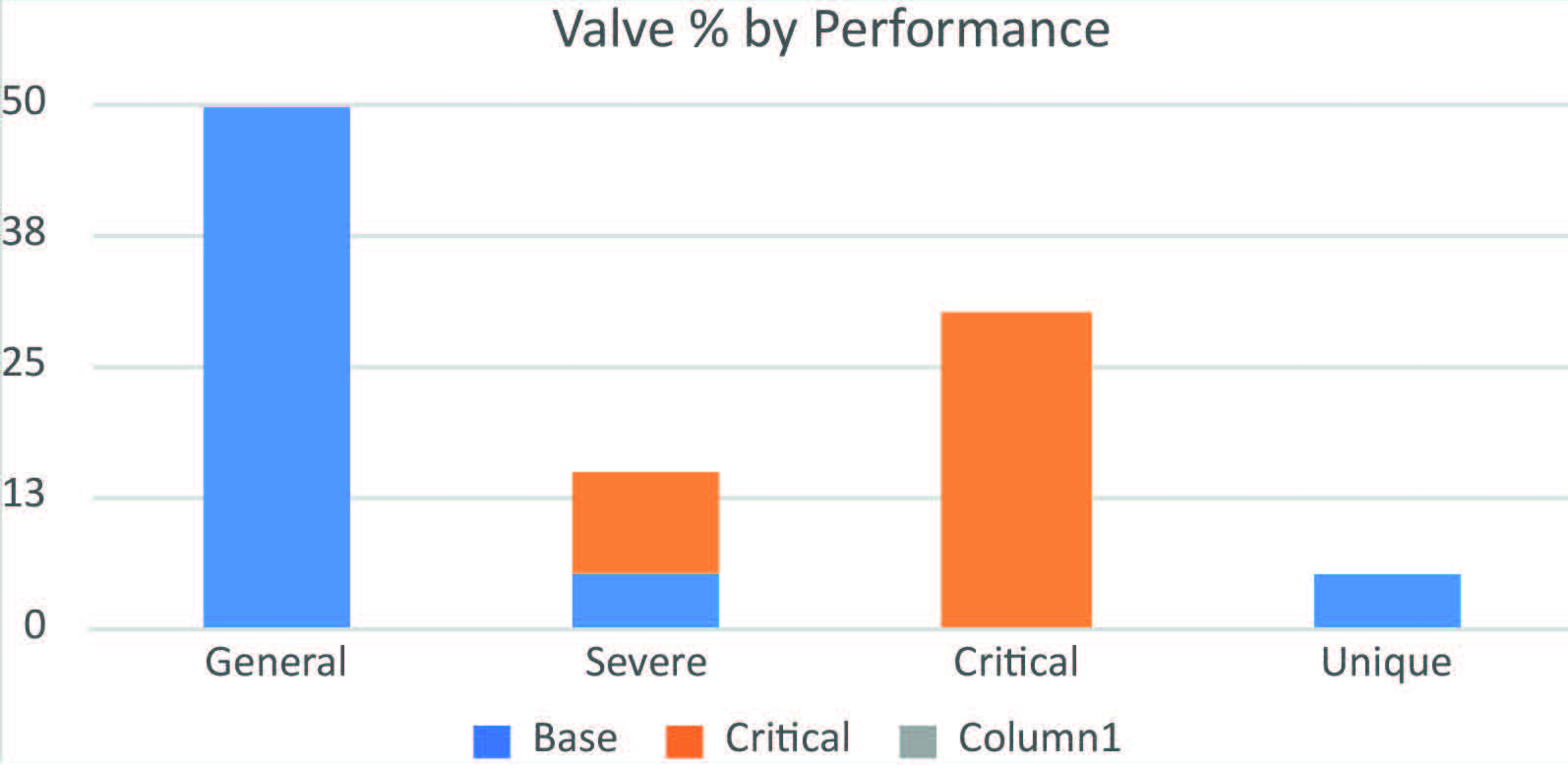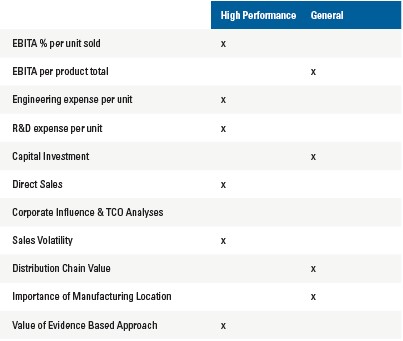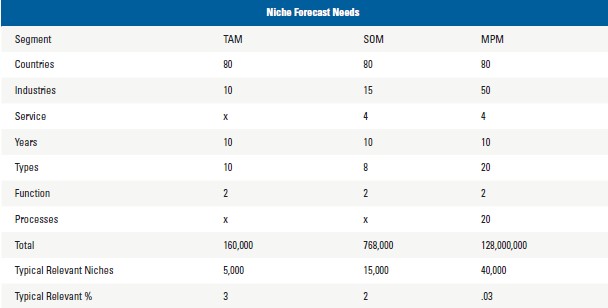Using an evidence based, forecast driven sales approach to sell products can maximize profits for valve companies. There are two variations of this approach based on whether the valve is in general or high-performance service.
By Robert McIlvaine, President & Founder – The McIlvaine Company
The capital investment and sales decisions differ greatly depending on whether the valve falls under the general or high-performance classification. The evidence needed to accurately make the forecast also differ as the former is based on logistics, and the latter on product performance.1
Valve performance categories include:
- General service
- Severe service
- Critical service
- Unique service
General service valves are those that have been purchased based on cost and delivery, rather than performance indicators. Severe service, on the other hand, are valves that are selected based on performance and are used in abrasive, corrosive, high temperature, and high-pressure applications. Critical service valves are similarly based on performance and are used in sanitary, and other applications, where performance is important to product quality or safety. Unique service includes special valves designed for a specific customer.
Figure 1 shows the market share percentage for each type of valve. The critical service category excludes critical valves, which are also in severe service.
Severe service, critical, and unique, are high performance service categories. In high performance service, the performance is more important than price or delivery.


General service includes valves sold as a commodity. For example, in a food processing plant, the valves on the municipal water intake pipeline would be in the general category. The valve moving food products would however be critical. The valves on the high pressure steam, would be severe service.
From a profitability strategy perspective, it is advantageous to contrast the high performance and general performance business factors. The comparison in Figure 2 shows which type produces higher results.
High performance valves can be sold at higher prices because of their unique qualities. Therefore, high earnings before interest, taxes, and amortization (EBITA), can be achieved for a relatively small number of valves. Many general valves are sold in large quantities, showing that the EBITA based on total revenue is higher than for a small niche market.
EBITA can also be increased by having lower production costs than the competition. This is more likely with large volume general performance products. Engineering and R&D expenses per unit sold are greater for high performance products to develop the unique features. Engineering and R&D for general performance valves can also be substantial if the focus is reducing manufacturing costs. But, the cost per unit sold would be low due to the high volume.
Capital investment will typically be higher for general performance valves due to the likelihood that the valves are produced in a supplier owned facility. High performance valves are also likely to include castings and components supplied by others. Sales of high performance valves depend on conveying knowledge of the superiority, so direct sales by knowledgeable individuals is important.
General purpose valves can be purchased with the simple total cost of ownership analysis based on price. The purchase of a high performance valve, however, warrants a total cost of ownership analysis. One large valve company found that local purchases tended to be based on price and experience. This precluded consideration of new and better valves.
Corporate staff took over the high performance valve decision making for several plants. The result was a considerable reduction in total cost of ownership. A large chemical company has a corporate staff assigned to valves and pumps, and strives to take advantage of all the improvements as they occur.
There tends to be volatility in the sales of high performance valves. For example, the market for valves for fracking fluctuates considerably. The market for valves used in water intakes in plants, in contrast, is relatively steady. The manufacturing location is also typically important for general purpose valves, where freight costs and delivery time are more relevant than for high performance valves.

Importance of Detailed and Current Forecasts
Very detailed forecasts for general and high performance valves are needed. Segmentation of high performance opportunities by critical, severe, and unique is needed in order to determine the most profit potential. In the case of high performance valves, this forecast will guide engineering and R&D efforts. In the case of general performance valves, the forecast will guide manufacturing investment.
Due to the Russian invasion of Ukraine, and the Chinese lockdown, the valve markets are rapidly changing, making continuous forecasts necessary.
The most profitable market can be a large number of small niches. IDEX is an example of a company with close to 30% EBITA and fairly large volume. However, the company consists of a number of independent divisions each pursuing unique niches. Identifying these profitable niches requires much more detailed market analysis than is typically pursued by valve companies.
There are various levels of forecasting available. The Total Available Market (TAM) includes all of the opportunities, whether they can be serviced, and are obtainable, or not. The Serviceable Obtainable Market (SOM) reflects the market which can be pursued. However, much of this market will not be very profitable. A much more detailed forecast is needed which analyzes all the niches and determines where the most profit can be achieved.
The ability to calculate any of 128 million niches relies on top-down, bottom-up, and horizontal iteration. It would be prohibitively expensive to conduct for just one category such as valves. But, if the expense is diluted by including forecasts of equipment using valves, plus complimentary air, water, and energy products, the cost for the valve analysis is reduced.
A typical example would be a company of medium size who would be involved in 5,000 niches or 3% of the TAM. With further segmentation in SOM, the number expands to 15,000 and the percentage drops to 2%. The most profitable market may involve 40,000 niches or just .03% of the total. If competitor market shares and sales quotas for territories are also included, the number could rise significantly. This effort will be relatively expensive, but as part of an evidence based sales program, the benefits far outweigh the costs.
Evidence Based Strategy
The same evidence needed to select the most profitable market niches is also needed to convince purchasers in those niches that a valve is superior. This evidence includes understanding the process needs in each industry. Once the most profitable market is determined, the evidence can be used to validate the lower total cost of ownership. This also requires analysis of the competitor’s valves, and determining the comparative costs.
The sequence to the evidence gathering process is as follows:
- Raw data,
- Predicate evidence,
- Disputed evidence,
- Claims based on the evidence,
- Rebuttal to counter claims made by competitors.
Suppliers have the opportunity to accomplish steps 2-5 in advertisements, magazine articles, exhibition activities, white papers, and webinars. It is not enough to prove the lower total cost of a valve, it is also necessary to convince the customers with solid evidence. This is a challenge, but a rewarding one, with the potential to greatly increase revenues and EBITA.



 Bob McIlvaine founded the McIlvaine Company in 1974 and oversees the work of 30 analysts and researchers. He has a BA degree from Princeton University.
Bob McIlvaine founded the McIlvaine Company in 1974 and oversees the work of 30 analysts and researchers. He has a BA degree from Princeton University.